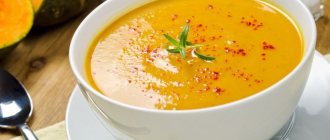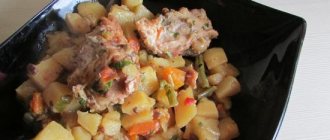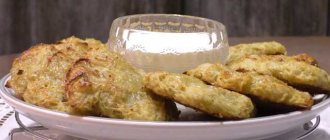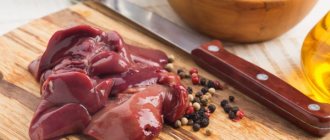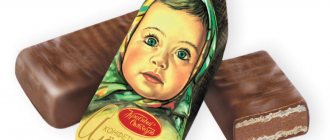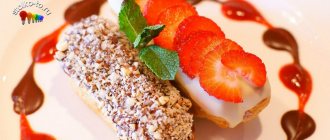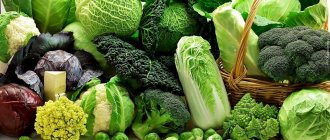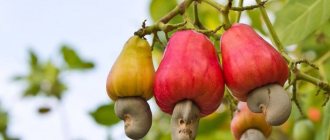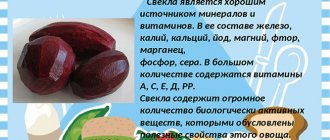Pea varieties for puree
Pea puree, the calorie content of the finished dish from which depends on the method of heat treatment, can be prepared from 2 types of legumes:
- Vegetable snap peas (sugar). This is a green variety, for which the largest peas are selected for canning, freezing or drying.
- Cereal varieties that turn yellow at maturity. This type has a long shelf life and hardness, which causes long soaking before cooking.
Chemical composition of pea puree
Pea puree contains many vitamins and microelements necessary for the functioning of the body:
- cellulose;
- vitamin A (retinol equivalent);
- IN 1;
- AT 2;
- AT 5;
- AT 6;
- AT 9;
- WITH;
- D;
- E;
- N;
- RR;
- beta-carotene;
- water;
- iron;
- iodine;
- potassium;
- calcium;
- cobalt;
- magnesium;
- manganese;
- copper;
- sodium;
- sulfur;
- phosphorus;
- fluorine;
- chlorine;
- cholesterol;
- chromium;
- zinc.
Contents of the BZHU
In addition to vitamins and microelements, pea puree contains proteins, carbohydrates and fats, the amounts of which are presented in the table:
| Component | Quantity per 100 g of finished product | Part of the daily value |
| squirrels | 5.2 g | 5,6 % |
| fats | 4.5 g | 6,6 % |
| carbohydrates | 10.9 g | 7,7 % |
The number of calories in 1 serving of a prepared dish depends on the cooking method and other components and is presented in the table:
| Cooking method | Calories |
| cooking on water | 89.3 kcal |
| with added chicken | 93 kcal |
| with stew | 126 kcal |
| with butter | 140 kcal |
| with pork or beef | 200 kcal |
| with the addition of fried onions | 285 kcal |
How is it used in dietetics and for weight loss?
Pea porridge is irreplaceable for those who are on a diet and want to lose weight. The product contains everything you need to replenish the body with useful minerals, vitamins, protein, antioxidants and normalize carbohydrate and protein balance.
Nutritionists advise staying on a pea diet for 3-7 days, eating 80-150 g of porridge per day. This is enough to lose a few kilos. And you don't have to starve. On the contrary, it is worth diversifying the pea menu with spinach, beets, beans, carrots, meat, bread, and chicken breast.
Also periodically arrange fasting days. In dietetics there is a concept - a method of one-day fasting. Boil 200 g of dry peas without salt, divide into 6 servings. If you stick to it every day, you can actually lose several kg per week. You can simply eat pea porridge every day for lunch, but without flavoring it with oil or smoked meats when cooking.
If you combine peas with parsley and dill, the harmful effect on food digestion will be reduced.
To lose weight and enhance the dietary effect, it is recommended to cook porridge in water. You can add butter, sunflower oil. However, the calorie content will increase slightly, and it will become difficult to fight excess weight. The ideal combination is porridge with fruits and vegetables.
It is unlikely that the body will survive stress if you give up some familiar foods. The main thing when losing weight is to consume pea porridge in moderation, in small portions. This is a fairly heavy product that should not be abused.
The benefits and harms of the dish
Pea puree has a positive effect on the functioning of the body for a number of reasons, including:
- due to the presence of vitamins and microelements in the composition, immunity is increased and health is improved;
- Peas contain vegetable protein, which helps in cell formation and muscle tissue growth;
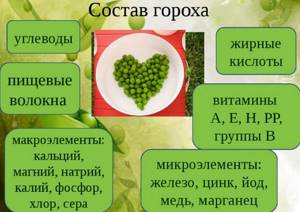
- if you add greens to the finished dish, it will help increase appetite and stimulate digestion;
- the fiber in the composition allows you to cleanse the digestive tract and get rid of constipation;
- the dish strengthens the heart muscle and improves blood circulation;
- Pea puree provides quick saturation and gives tone to the body.

Eating pea puree can negatively affect the functioning of the body.
A negative reaction is due to the following properties:
- if you have a history of problems with the gastrointestinal tract, the dish may cause increased gas formation and bloating;
- It is also necessary to limit the consumption of pea puree for people who have problems with the functioning of the kidneys, heart, or diabetes, since the dish can aggravate the chronic condition of the disease;
- Children under 3 years of age should avoid consuming pea puree, as the dish can cause increased gas formation and severe abdominal pain.
Percent Daily Value
The amount of microelements and vitamins in pea puree is presented in the table:
| Component | Quantity per 100 g of finished product | Part of the daily value |
| cellulose | 2.7 g | 14 % |
| Vitamin A (retinol equivalent) | 17.4 mcg | 1,9 % |
| IN 1 | 0.115 mg | 7,7 % |
| AT 2 | 0.036 mg | 2 % |
| AT 5 | 0.537 mg | 11 % |
| AT 6 | 0.084 mg | 4,2 % |
| AT 9 | 4.813 mcg | 1,2 % |
| WITH | 0.65 mg | 0,7 % |
| D | 0.039 mcg | 0,4 % |
| E | 1.024 mg | 6,8 % |
| N | 4.6 mcg | 9,1 % |
| RR | 1.58 mg | 7,9 % |
| beta carotene | 0.012 mg | 0,2 % |
| water | 75 g | 2,7 % |
| potassium | 187 mg | 7,5 % |
| calcium | 28.6 mg | 2,9 % |
| magnesium | 22 mg | 5,5 % |
| sodium | 133 mg | 10 % |
| sulfur | 48,5 % | 4,9 % |
| phosphorus | 59.1 mg | 7,4 % |
| chlorine | 211 mg | 9,2 % |
| iron | 1.7 mg | 9,3 % |
| iodine | 13.4 mcg | 8,9 % |
| cobalt | 2.7 mcg | 27 % |
| manganese | 0.19 mg | 9,6 % |
| copper | 147.3 mcg | 15 % |
| fluorine | 69.07 mcg | 1,7 % |
| chromium | 0.26 mcg | 0,5 % |
| zinc | 0.67 mg | 5,6 % |
| cholesterol | 4.9 mg | 1,6 % |
Boiled peas of various varieties: calorie content per 100 g
Pea puree, whose caloric content differs depending on the type of legume, saturates the body with vitamins and microelements, and also provides a surge of energy due to its carbohydrate content.
The number of calories of each pea variety is presented in the table:
| Type of culture | Number of calories per 100 g of finished dish | Features of use |
| dry shelling peas | 35 kcal | Suitable for dietary nutrition, as well as making purees, side dishes, and first courses. |
| sugar snap peas | 45 kcal | Suitable for canning |
| brain peas | 80 kcal | Suitable for canning |
Dietary properties:
How many calories are in pea porridge, what dietary properties it has, all this is of great interest to those who lead a healthy lifestyle and watch their figure. So we will try to answer these questions in the next article.
So here it is:
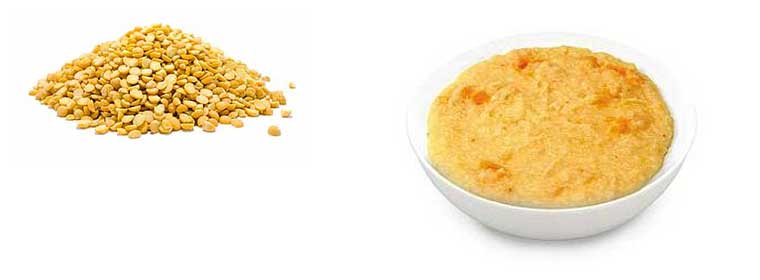
Porridges began to be cooked from peas back in ancient times in the cuisine of different nations. It was and remains a very inexpensive and useful product that everyone can afford. It is most popular among the Slavs.
Everyone probably knows that this herbaceous plant belongs to the legume family. This is not only a beautiful, but also a useful culture. Delicious porridges are prepared from its grains, which are rich in nutrients, vitamins and dietary fiber. Pea porridge is useful because it contains valuable vegetable protein and starch. It contains a lot of carbohydrates and natural sugars.
This dish is prepared by boiling shelled peas in water. As a rule, vegetable oil, various spices and seasonings are added to it.
In addition to a balanced amino acid composition with a considerable number of essential components, this porridge can boast of the presence of a natural antioxidant - vitamin E, which inhibits the aging process and has a beneficial effect on the skin. It contains vitamin A, which makes vision sharper, and ascorbic acid (vitamin C), which strengthens immune defense and helps prevent colds.
In addition, peas contain B vitamins, which are necessary for the health of the central nervous system and hematopoietic processes. Among the minerals, it should be noted calcium, which strengthens bone tissue, magnesium and potassium, necessary for the functioning of the heart, iron, without which the synthesis of red blood cells cannot take place.
For vegetarians and simply for people who prefer a healthy lifestyle, pea porridge is an essential and sometimes vital product that has enormous nutritional value due to its high vegetable protein content. In addition, legumes, and in particular peas, should be included in the diet of every person, regardless of gender, age and nationality, regardless of what kind of work - physical or mental - he is more occupied. This dish saturates our body with vital energy for productive work, improves brain functioning, speeds up reaction and adaptation to stressful situations. It is often included in the diet of athletes, as well as in the menu of fasting days.
How to reduce the energy value of a dish?
Pea puree is a dish that is prepared mainly in water with the addition of butter and salt. For people who are on a diet, there are some restrictions in preparing the dish to reduce its nutritional value.
The calorie content of the product can be reduced in the following ways:
- for cooking, you must choose frozen peas; after heat treatment, their calorie content will not exceed 33 kcal;

- if you cook peas with the addition of lean meat, the calorie content will be 50 kcal;
- Also, do not fry for pureed pea soup.
How to choose peas for porridge

Seed peas are usually split into two parts or left whole. The separated parts cook much faster, and the unhusked product retains more useful elements. Therefore, it doesn’t matter which option you choose, because you are unlikely to be able to buy dry pea cereal of poor quality, just pay attention to the absence of impurities and debris in the bag. Only from such peas will the most delicious pea porridge with meat be obtained.
Delicious pea puree recipes for regular and dietary meals
To make pea puree tasty, you need to take into account the general recommendations for preparing this dish:
- peas must be washed 6 times before cooking;
- only dried beans are suitable for making porridge and puree;
- soaking peas should not last more than 12 hours, as the product will become hard;
- when soaking water, it is necessary to pour 2-3 cm more water, since the peas will increase in size;
- It is better to salt the dish at the end of cooking;
- the pan should not be covered with a lid during cooking;
- if the water has boiled away, you need to add the same amount of boiling water, not cold liquid.
With butter and fried onions
For preparation you need the following ingredients:
- water – 4 tbsp.;
- peas – 300 g;
- carrots – 150 g;
- butter – 50 g;
- onions – 2 pcs.;
- garlic – 3 cloves;
- sunflower oil – 50 ml;
- salt - to taste.
Step-by-step cooking process:
- First, peas must be washed and soaked in water overnight.
- Then in the morning you need to add 1 tbsp to the container. water and put it on fire.
- Then, after boiling, you should reduce the heat to a minimum and continue cooking, stirring the peas, for 1-1.5 hours. If the water boils away, then it needs to be added.
- After time, the peas should be boiled. If this does not happen, you can beat it with a blender.
- Next, at the end of cooking, you need to add butter.
- While the peas are cooking, chop the onions and carrots, fry until golden brown and add chopped garlic.
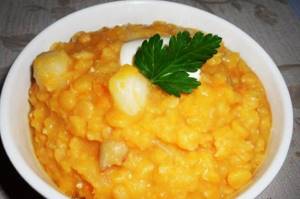
Before serving pea puree, you need to add sauteed vegetables to it.
Calorie content – 187 kcal per 100 g of dish.
With milk
For preparation you need the following ingredients:
- peas – 500 g;
- milk – 500 ml;
- butter – 50 g;
- salt - to taste.
Step-by-step cooking process:
- Peas must be soaked in cold water for 4 hours.
- Next, without draining the water, you should boil the product.
- After cooking is finished, the liquid must be drained using a sieve and the peas must be beaten in a blender.
- Pour previously boiled milk into the whipped mass, add butter and salt.
- Pea puree should be mixed thoroughly.
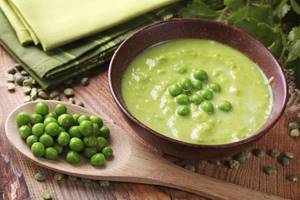
You can serve the dish on its own or as an addition to potatoes.
Calorie content of 100 g of ready-made dish is 97 kcal.
With lard
For preparation you need the following ingredients:
- peas – 400 g;
- lard – 200 g;
- medium-sized onion – 4 pcs.;
- dill – 30 g;
- water or broth - 4 tbsp;
- salt - to taste.
Step-by-step cooking process:
- First, rinse the peas until the water runs clear. Next, the product should be soaked for 4-6 hours. When time has passed, the water should be drained.
- Next, add broth to the peas and cook. After boiling, reduce the heat to medium and continue cooking for another 50 minutes. If liquid remains, the dish must be cooked until it evaporates.
- Then the lard should be cut into cubes, and the onion into half rings.
- Next, you need to fry the lard on both sides until golden brown and place on a plate.
- After this, without washing the pan, fry the onion in the fat from the lard.
- Then, when the onion is ready, you need to turn off the heat and return the lard to the container.

Pea puree, whose calorie content is 300 kcal per 100 dishes, can be served by mixing all the ingredients or laying lard on top of the dish.
With mint
The following ingredients are needed for the cooking process:
- frozen green peas – 500 g;
- green onions – 50 g;
- mint – 30 g;
- butter – 40 g;
- vegetable oil – 30 g;
- salt and pepper - to taste.
For cooking, you can take fresh green peas. With this component the finished dish will be sweeter.
Step-by-step cooking process:
- First, you need to thoroughly rinse the greens and shake off excess water.
- Next, the greens and mint should be cut into large pieces. At this stage, you should not grind the components, since later they will be ground in a blender.
- Pour vegetable oil into a heated frying pan and fry the green onions in it for 3 minutes. Next, add mint and fry for another 2 minutes.
- Then you need to pour the peas into the pan, wait until they defrost, and simmer for another 10 minutes.
- When the required time has passed, you need to turn off the heat, open the lid and add spices.
- Next, the finished mass must be placed in a deep container and blended with a blender.
- Then you need to add butter to the whipped puree.

You can serve mashed potatoes as a side dish or as an addition to the main dish.
Calorie content of 100 g of the finished product is 145 kcal.
With mushrooms and gravy
For preparation you need the following ingredients:
- peas – 300 g;
- champignons – 300 g;
- carrots – 200 g;
- potatoes – 300 g;
- butter – 90 g;
- meat – 600 g;
- garlic – 3 cloves;
- cream – 100 ml;
- salt and spices - optional.
Step by step process for making gravy:
- First, the meat must be washed under water, then cut into cubes.
- Next, peel the onions and carrots. Then you need to cut the onion into cubes and grate the carrots.
- Then all the ingredients must be mixed in a frying pan, seasoned and simmered until the meat is cooked.
- Next, grate the champignons on a coarse grater and add to the meat, continue simmering for another 7 minutes.
- Then you need to pour the cream into the pan, let the mixture boil and add chopped garlic.
Pea puree is prepared as follows:
- First, the peas must be soaked for 4 hours.
- Next, in separate pans, boil the peas and potatoes until tender.
- Then you need to beat the peas with a blender, mash the potatoes and mix the ingredients, including the meat gravy.
- Then you need to add salt and butter to the finished mass.
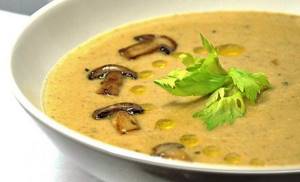
You can serve the dish with a salad of fresh vegetables.
Calorie content of 100 g of ready-made dish is 200 kcal.
With fish
For preparation you need the following ingredients:
- peas – 400 g;
- water – 4 tbsp.;
- vegetable oil – 150 ml;
- fish – 600 g;
- onion – 100 g;
- flour – 100 g;
- bay leaf – 3 pcs.;
- salt and seasonings - to taste.
Step-by-step cooking process:
- First, peas must be rinsed under water and soaked for 3-4 hours.
- Next, without draining the water, you should cook the product until it becomes porridge.
- Then, when the peas begin to boil, the excess water needs to be drained and the remaining mass crushed.
- Then the fish must be washed and cleaned, cut into pieces and seasoned with spices, and also rolled in flour.
- After this, the pieces of fish should be fried over medium heat on both sides until golden brown, then add the onion, previously cut into half rings, and bay leaf.
- Next, cover the pan with a lid and simmer for 10-15 minutes.

You can serve the dish to the table separately, as a complement to each other.
Calorie content of 100 g of ready-made dish is 180 kcal.
With smoked meats in a pressure cooker
For preparation you need the following ingredients:
- polished peas – 300 g;
- smoked meats to choose from – 100-150 g;
- water – 600 ml;
- salt – 0.5 tsp.
Step-by-step cooking process:
- First, the smoked meats must be cut into cubes, the peas must be washed, but not soaked.
- Next, place the food in the pressure cooker, add salt and water.
- Then on the device you need to set the cooking mode to “Soup”, time – 30 minutes, pressure – 0.7 b.
- After this, the cooking process must be started with the pressure release valve closed.
- After the specified time has ended, the lid of the pressure cooker must be opened, releasing steam, and stir the dish with a spoon.
The dish can be served at any time of the day. To add flavor, add onions fried in a frying pan.
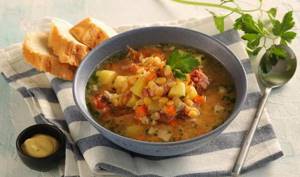
Calorie content of 100 g of ready-made dish is 350 kcal. Smoked meats contain the largest share of it. If you reduce their quantity in the recipe, the energy value of the dish will be lower. Peas cooked in a pressure cooker have a calorie content of 88 kcal per 100 g of finished product.
With chicken, mushrooms and onions in a pot for the oven
For preparation you need the following ingredients:
- peas – 300 g;
- champignons – 300 g;
- chicken – 300 g;
- onion – 100 g;
- sour cream – 120 ml;
- water – 200 ml;
- vegetable oil – 20 ml;
- salt and seasonings - optional.
Step-by-step cooking process:
- Before starting cooking, the pots must be soaked in cold water for 2 hours so that they are saturated with moisture.
- After this, the peas must be washed and divided into 2 parts.
- Then the bottom of the pot should be greased with oil and 1 part of the peas should be placed there.
- Then you need to place meat and mushrooms, cut into cubes, on top of the peas, then onions, cut into rings. The last layer should be 2 parts of peas.
- After this, the dish must be salted, spices, herbs and sour cream added.
- Next, you should pour enough water into the pot so that it reaches the hangers.
- Then you need to put the pots in a cold oven, set the temperature to 180 °C and bake for 2 hours.

The dish must be served in pots
Calorie content of 100 g of finished puree is 400 kcal.
With meat in a slow cooker
For preparation you need the following ingredients:
- chicken breast – 400 g;
- peas – 500 g;
- carrots – 1 pc. large;
- onion – 1 pc. medium size;
- vegetable oil – 20 ml;
- salt and spices - to taste.
Step-by-step cooking process:
- First, peas need to be washed and soaked for 4 hours.
- Then the meat must be washed, wiped with a napkin and cut into medium-sized cubes.
- After this, the onion should be peeled and chopped, and the carrots should be grated on a coarse grater.
- Then on the multicooker you need to select the “Baking” mode and pour in the oil. When the bowl is hot, you need to put the meat in it and fry for 10 minutes, after which you should add the chopped vegetables and fry for another 10 minutes.
- Next, you need to pour peas into the bowl, pour in water, add spices and salt.
- Then you should change the mode to “Extinguishing”, close the lid and steam release valve, and set the time to 50 minutes. - this way the peas will be cooked, but not boiled.
- The finished dish must be mashed to a puree.
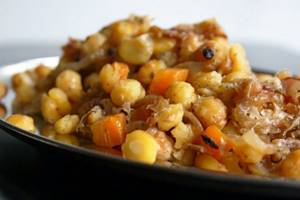
The dish must be served in portions with meat. Additionally, you can put the salad on a plate and garnish with herbs.
Calorie content of 100 g of ready-made dish is 110 kcal.
Cream soup for weight loss with water without oil
For preparation you need the following ingredients:
- water – 5 l;
- celery root – 200 g;
- carrots – 400 g;
- peas – 250 g;
- onion – 150 g.
Step-by-step cooking process:
- First you need to wash the peas and soak them in cold water for 12 hours.
- Before preparing the puree, you should cook the broth from water, 200 g of carrots and celery.
- Then you need to drain the water, pour the peas into the broth and cook until the product softens.
- While the peas are cooking, chop the remaining 200 g of carrots and onions, place them on a baking sheet and simmer in an oven preheated to 180 °C for 10 minutes.
- Then the vegetables must be placed in the soup 5 minutes before the end of cooking.
- At the end of the cooking process, you can add salt and spices, but nutritionists recommend reducing their consumption.
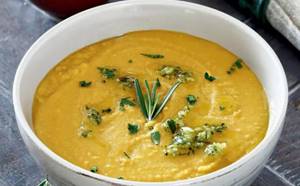
Calorie content of 100 g of ready-made dish is 60 kcal.
Pea puree is a universal dish that can be eaten at any time of the day. Its calorie content depends on the method of preparation and increases with the addition of meat, smoked meats or fried onions.
More on the same topic:
4 comments
- LenaRU Writes, By the way, pea porridge also has contraindications. Peas contain quite a lot of so-called purines. These substances contribute to the accumulation of uric acid in the blood and the deposition of urates in the joints. Therefore, porridge with peas is not recommended for frequent consumption by older people and those who are prone to gout.
- Chef Writes,
You can cook not just pea porridge, but for example, pea porridge with buckwheat and potatoes. It works out very well! Potatoes with buckwheat are added to the boiling peas when they are half cooked. When all the ingredients of the porridge are cooked, add milk, salt, bring to a boil and grind into a homogeneous mass. You can also add onions fried in oil. - DonJ Writes,
Pea porridge? This is not for me. We also found food! - Red hair Writes,
Residents of our country are sure that peas appeared in Russia, after which all other nations learned about such a culture. However, we got peas from eastern countries. The benefits of pea porridge were known to the inhabitants of the Mediterranean. In the distant past, the ancestor of modern peas grew here.
